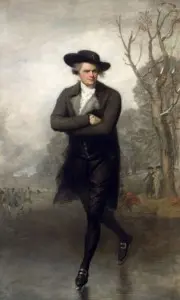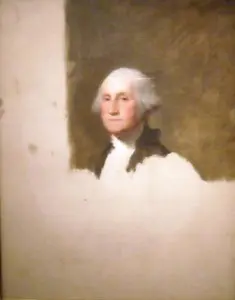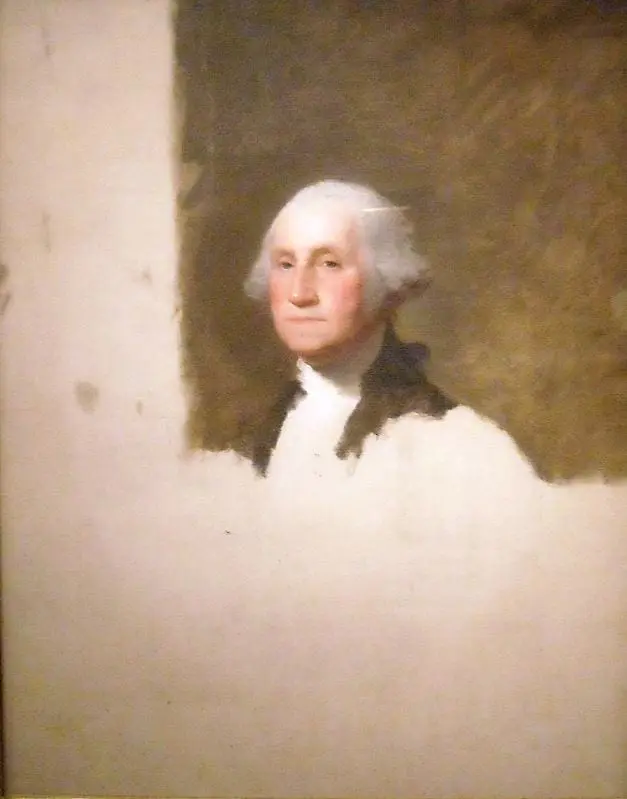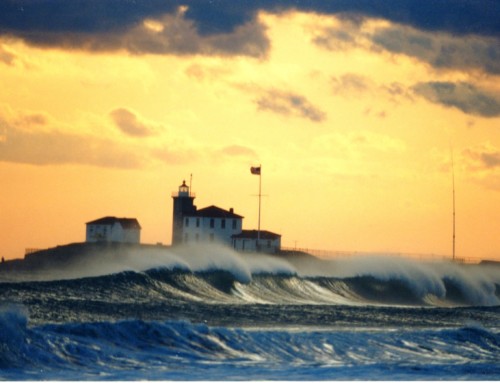Rhode Island has many little known places of interest that people should know about. The Gilbert Stuart Birthplace and Museum is one of the best examples. Situated on 24 acres with herb gardens and nature trails the attractions include an authentically restored 1750 home and snuff mill furnished with period antiques. A large wooden waterwheel powered the snuff mill which used to grind locally grown tobacco in colonial times.
The fully restored 18th-century Hammond Gristmill is also at the site and houses the original 1757 granite millstones.After a final restoration in 2007 water once again powers the millstones. The Bell Art Gallery provides the perfect setting for the presentation of a changing collection of fine art from both locally and historically renowned artists.
So, who is Gilbert Stuart you might ask? I’ll give you a hint. Every time you pull out a dollar bill you see his artwork. That’s right; Gilbert Stuart painted the famous likeness of George Washington that’s on the dollar bill. Gilbert Stuart is widely considered to be one of America’s foremost portraitists. He left a legacy of memorable portraits, over 1,000 done in his lifetime. He immortalized Presidents Washington, Jefferson, Madison, Monroe, John Adams, John Quincy Adams, and many prominent statesmen of the day.

Stuart decided to leave Newport prior to the American Revolution but not for political reasons. He moved to London, England but couldn’t find work. Finally, after living as the proverbial starving artist he met Benjamin West, another American painter, who was a highly successful and gifted artist.
West hired Stuart as an apprentice and Stuart worked for a number of years in his studio until he painted a portrait which would change his fortunes.
The portrait was for William Grant, a well-placed young Scotsman, who wished to commission a full-length portrait. Stuart had not yet successfully completed a figure in full-length but encouraged by the recent reception of his work at the Royal Academy, he agreed to accept the commission from Grant.

After being recognized by the Royal Academy he moved into his own studio and lived in England until 1787 when he fled to Ireland to escape debts. He moved to Ireland, then finally back to New York, after living abroad for 18 years.
Arriving back in the states Stuart had letters of introduction to a number of people including a letter of introduction to George Washington from Chief Justice John Jay. In 1794 he moved to Philadelphia and left his calling card at the home of Washington. A year later Washington finally agreed to sit for a portrait, it was the highlight of Stuart’s life and the opportunity he’d waited for. In some accounts Washington was cross and nervous during the sitting, Stuart was quite droll and could be entertaining and he tried to get Washington to relax. This first painting of Washington is called the Vaughan Painting and it shows a very formal and stiff Washington.
The following year Martha Washington wanted to have a full-length portrait of her husband done. Again, Washington came and sat for Stuart but this time they had a lively conversation about farming and horses. Washington had always been very self-conscious about his ill-fitting false teeth but in this case Stuart got Washington to relax. After getting the upper body and face done Stuart knew that he’d nailed it. He had captured not just the physical presence but the essence of the most famous man in the world. He stopped painting after completing just the head and shoulders because it was perfect the way it was. He asked Washington if he could keep the unfinished painting and Washington agreed.
Over the years Stuart kept that painting in his studio and used it to make copies from. There was a market for images of the county’s beloved leader and many people hired Stuart to make them. He did at least seventy-five copies of the unfinished portrait and sold them for one-hundred dollars each. He called them his hundred dollar bills.
When Stuart passed away in Boston on July 9, 1828, he still had the unfinished portrait of Washington in his studio. His daughter, Jane Stuart, was in charge of her father’s estate and had to disperse his property including the famous unfinished painting of Washington and a painting of Martha Washington. The paintings were sold to the Boston Athenaeum and they became known as the Athenaeum Portraits. The painting of Washington is also known as the Unfinished Portrait and today both paintings can be seen at the Museum of Fine Arts in Boston. They are shared every three years with the National Portrait Gallery at the Smithsonian Museum.
I wondered why Gilbert Stuart isn’t well known. The museum director, Margaret O’Connor said, “Stuart is well known in the art world but people who live near the museum and have driven by the sign will come in and say, ‘who is this guy. I’ve driven by this sign for many years and I don’t know who he is.’ Our goal is to try and change that one visitor at a time.”







